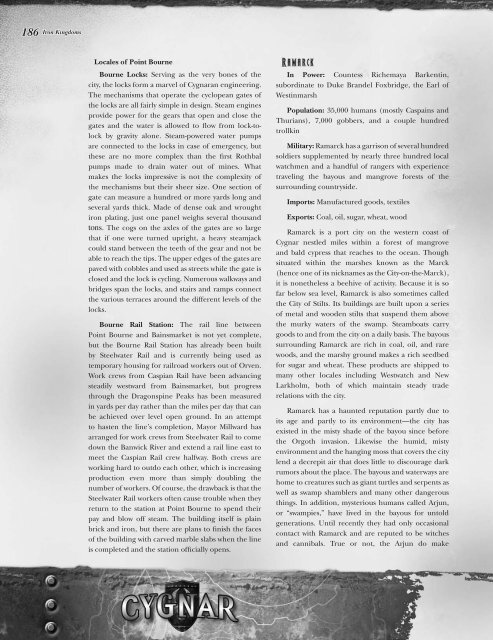02 - Iron Kingdoms W.. - Captain Spud Is Amazing
02 - Iron Kingdoms W.. - Captain Spud Is Amazing
02 - Iron Kingdoms W.. - Captain Spud Is Amazing
You also want an ePaper? Increase the reach of your titles
YUMPU automatically turns print PDFs into web optimized ePapers that Google loves.
186 <strong>Iron</strong> <strong>Kingdoms</strong><br />
108.1.141.197<br />
Locales of Point Bourne<br />
Bourne Locks: Serving as the very bones of the<br />
city, the locks form a marvel of Cygnaran engineering.<br />
The mechanisms that operate the cyclopean gates of<br />
the locks are all fairly simple in design. Steam engines<br />
provide power for the gears that open and close the<br />
gates and the water is allowed to flow from lock-tolock<br />
by gravity alone. Steam-powered water pumps<br />
are connected to the locks in case of emergency, but<br />
these are no more complex than the first Rothbal<br />
pumps made to drain water out of mines. What<br />
makes the locks impressive is not the complexity of<br />
the mechanisms but their sheer size. One section of<br />
gate can measure a hundred or more yards long and<br />
several yards thick. Made of dense oak and wrought<br />
iron plating, just one panel weighs several thousand<br />
tons. The cogs on the axles of the gates are so large<br />
that if one were turned upright, a heavy steamjack<br />
could stand between the teeth of the gear and not be<br />
able to reach the tips. The upper edges of the gates are<br />
paved with cobbles and used as streets while the gate is<br />
closed and the lock is cycling. Numerous walkways and<br />
bridges span the locks, and stairs and ramps connect<br />
the various terraces around the different levels of the<br />
locks.<br />
Bourne Rail Station: The rail line between<br />
Point Bourne and Bainsmarket is not yet complete,<br />
but the Bourne Rail Station has already been built<br />
by Steelwater Rail and is currently being used as<br />
temporary housing for railroad workers out of Orven.<br />
Work crews from Caspian Rail have been advancing<br />
steadily westward from Bainsmarket, but progress<br />
through the Dragonspine Peaks has been measured<br />
in yards per day rather than the miles per day that can<br />
be achieved over level open ground. In an attempt<br />
to hasten the line’s completion, Mayor Millward has<br />
arranged for work crews from Steelwater Rail to come<br />
down the Banwick River and extend a rail line east to<br />
meet the Caspian Rail crew halfway. Both crews are<br />
working hard to outdo each other, which is increasing<br />
production even more than simply doubling the<br />
number of workers. Of course, the drawback is that the<br />
Steelwater Rail workers often cause trouble when they<br />
return to the station at Point Bourne to spend their<br />
pay and blow off steam. The building itself is plain<br />
brick and iron, but there are plans to finish the faces<br />
of the building with carved marble slabs when the line<br />
is completed and the station officially opens.<br />
Ramarck<br />
In Power: Countess Richemaya Barkentin,<br />
subordinate to Duke Brandel Foxbridge, the Earl of<br />
Westinmarsh<br />
Population: 35,000 humans (mostly Caspains and<br />
Thurians), 7,000 gobbers, and a couple hundred<br />
trollkin<br />
Military: Ramarck has a garrison of several hundred<br />
soldiers supplemented by nearly three hundred local<br />
watchmen and a handful of rangers with experience<br />
traveling the bayous and mangrove forests of the<br />
surrounding countryside.<br />
Imports: Manufactured goods, textiles<br />
Exports: Coal, oil, sugar, wheat, wood<br />
Ramarck is a port city on the western coast of<br />
Cygnar nestled miles within a forest of mangrove<br />
and bald cypress that reaches to the ocean. Though<br />
situated within the marshes known as the Marck<br />
(hence one of its nicknames as the City-on-the-Marck),<br />
it is nonetheless a beehive of activity. Because it is so<br />
far below sea level, Ramarck is also sometimes called<br />
the City of Stilts. Its buildings are built upon a series<br />
of metal and wooden stilts that suspend them above<br />
the murky waters of the swamp. Steamboats carry<br />
goods to and from the city on a daily basis. The bayous<br />
surrounding Ramarck are rich in coal, oil, and rare<br />
woods, and the marshy ground makes a rich seedbed<br />
for sugar and wheat. These products are shipped to<br />
many other locales including Westwatch and New<br />
Larkholm, both of which maintain steady trade<br />
relations with the city.<br />
Ramarck has a haunted reputation partly due to<br />
its age and partly to its environment—the city has<br />
existed in the misty shade of the bayou since before<br />
the Orgoth invasion. Likewise the humid, misty<br />
environment and the hanging moss that covers the city<br />
lend a decrepit air that does little to discourage dark<br />
rumors about the place. The bayous and waterways are<br />
home to creatures such as giant turtles and serpents as<br />
well as swamp shamblers and many other dangerous<br />
things. In addition, mysterious humans called Arjun,<br />
or “swampies,” have lived in the bayous for untold<br />
generations. Until recently they had only occasional<br />
contact with Ramarck and are reputed to be witches<br />
and cannibals. True or not, the Arjun do make


